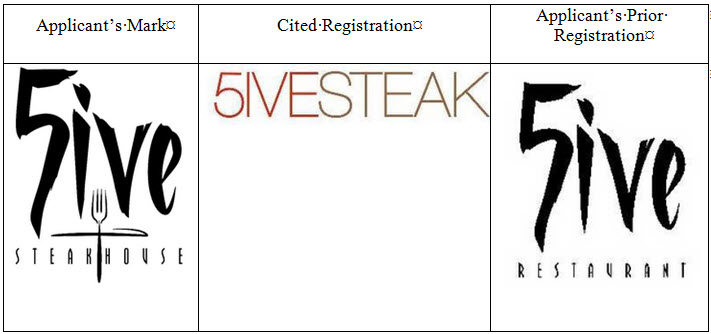Recent TTAB Decision Denying Application Shows Importance of Policing Trademark And Risk Of Relying Too Heavily On Prior Registration
Securing a federal trademark registration is never a guarantee, even when the applicant has an incontestable registration for a very similar mark. In In re Inn at St. John’s, LLC (June 6, 2018), the Trademark Trial and Appeal Board (the “Board”) affirmed the refusal to register 5IVE STEAKHOUSE (stylized) based on a likelihood of confusion with a registration for 5IVE STEAK (stylized). The decision was somewhat surprising when you look at the marks at issue (shown below) and is a reminder that applicants cannot always rely on an a prior registration to expand a brand.

In analyzing the similarity of the marks, the Board focused on the similar wording and seemed to give little weight to the stylization of the marks. The applicant was not successful in convincing the Board that 5IVE was frequently used with restaurant services and therefore a weak term entitled to narrow protection. From there, the Board found that “[t]he marks are similar because they share the identical term 5IVE and the highly similar terms ‘Steak’ and ‘Steakhouse.’” With respect to the design features of the marks, the Board noted the frequently-cited rule that the literal portions of a mark are likely to make a greater impression on the minds of a consumer and concluded that was the case for the applicant’s mark: “[t]he knife-and-fork design included in Applicant’s mark is a relatively small element of the mark, and is at best suggestive of restaurant services.” As a result, the Board found the marks to be similar.
An applicant’s similar prior registration can be another probative fact in a likelihood of confusion analysis, but it did not help the applicant in this case. Here, the applicant relied on its registration for 5IVE RESTAURANT, which had coexisted on the register with the cited registration for over five years. The Board, however, considered the prior registration to be a neutral factor in its analysis because applicant’s mark “moves closer to the cited registration – 5IVESTEAK and design – than the mark in Applicant’s prior registration – 5IVE RESTAURANT and design – rendering the new mark more similar in appearance, sound, and meaning to Registrant’s mark, which includes the word STEAK and does not include the word RESTAURANT.” Having already decided that 5IVE was not descriptive, suggestive or weak as a source identifier for restaurant services, the Board’s decision really turned on the identical term 5IVE and the similarity of the wording STEAK and STEAKHOUSE in the marks.
The Board’s decision shows the risk in relying too heavily on a prior registration and highlights the importance of policing a trademark, especially one that may be used to grow a brand. Here, the applicant’s prior registration registered in 2005 and the cited registration was not used or filed until 2008, so the applicant could have opposed the 5IVESTEAK application.

